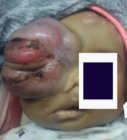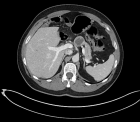Abstract
Case Report
Fever of Unknown Origin in Children: The Challenge of History Taking
S Testa, S Faranghi, S Mazzitelli, GB Beretta, G Di Pietro, G Renisi and Antonella Petaccia*
Published: 24 November, 2023 | Volume 7 - Issue 3 | Pages: 062-065
A fever of unknown origin (FUO) in children is usually described as a fever of at least 8 days duration with no apparent diagnosis after initial investigations, including taking medical history and preliminary laboratory assessment. Infectious diseases are the most common cause of FUO, followed by rheumatologic and neoplastic conditions.
In this report, we present a case of a 15-year-old Caucasian boy with a silent past medical history, who presented at our Pediatric ER department with a three-day history of fever, fatigue, and abdominal pain with diarrhoea. Initial laboratory testing and microbiological work-up were non-significant.
At hospital admission, a broad infectious diagnostic work-up was pursued, including serologies and polymerase-chain-reaction (PCR) for CMV, EBV, HAV, Parvovirus, Toxoplasma gondii and Adenovirus, all negative.
Given mild splenomegaly and linfadenopathy, systemic Juvenile Idiopathic Arthritis (s-JIA) was suspected, as well as Multi-inflammatory Syndrome in Children (MIS-C), but the patient did not meet their main diagnostic criteria. Malignancy was ruled out by a negative bone marrow fine-needle aspiration cytology and whole-body PET-CT scan.
On hospital day 8, Brucella was identified on a new set of blood cultures and a combined antibiotic therapy was started with IV Gentamicin plus per os Doxycycline. The patient’s general conditions rapidly improved, and both fever and diarrhoea resolved. A reassessment of the patient’s medical history before discharge revealed exposure to unpasteurized soft cheese in the weeks prior to the onset of symptoms. This case underlines the importance of taking a complete medical history, as well as a full diagnostic work-up to unveil unusual infectious etiologies behind FUO. After the preliminary negative microbiological tests, a connective tissue disease was ruled out (i.e. lack of cutaneous or articular involvement), as well as malignancy, which led to a closer evaluation for infection and the diagnosis of Brucellosis.
Read Full Article HTML DOI: 10.29328/journal.acr.1001081 Cite this Article Read Full Article PDF
Keywords:
Fever; Children; Brucella; Zoonosis
References
- Haidar G, Singh N. Fever of Unknown Origin. N Engl J Med. 2022 Feb 3;386(5):463-477. doi: 10.1056/NEJMra2111003. PMID: 35108471.
- Lohr JA, Hendley JO. Prolonged fever of unknown origin: a record of experiences with 54 childhood patients. Clin Pediatr (Phila). 1977 Sep;16(9):768-73. doi: 10.1177/000992287701600905. PMID: 891078.
- McClung HJ. Prolonged fever of unknown origin in children. Am J Dis Child. 1972 Oct;124(4):544-50. doi: 10.1001/archpedi.1972.02110160082009. PMID: 5080685.
- Hassan RH, Fouda AE, Kandil SM. Fever of Unknown Origin in Children: A 6 year- Experience in a Tertiary Pediatric Egyptian Hospital. Int J Health Sci (Qassim). 2014 Jan;8(1):13-9. doi: 10.12816/0006067. PMID: 24899875; PMCID: PMC4039580.
- Zhou W, Tan X, Li Y, Tan W. Human herpes viruses are associated with classic fever of unknown origin (FUO) in Beijing patients. PLoS One. 2014 Jul 3;9(7):e101619. doi: 10.1371/journal.pone.0101619. Erratum in: PLoS One. 2014;9(9): doi/10.1371/journal.pone.0110077. PMID: 24991930; PMCID: PMC4081597.
- Halevy J, Ash S. Infectious mononucleosis in hospitalized patients over forty years of age. Am J Med Sci. 1988 Feb;295(2):122-4. doi: 10.1097/00000441-198802000-00006. PMID: 3344759.
- Haidar G. HHV-6, HHV-7, and HHV-8: forgotten viruses in transplantation. In: Morris M, Kotton C, Wolfe C, eds. Emerging transplant infections. Cham, Switzerland: Springer: 2020; 683-708.
- Cleri DJ, Ricketti AJ, Vernaleo JR. Fever of unknown origin due to zoonoses. Infect Dis Clin North Am. 2007 Dec;21(4):963-96, viii-ix. doi: 10.1016/j.idc.2007.08.009. PMID: 18061085; PMCID: PMC7135411.
- Calabro JJ, Marchesano JM. Juvenile rheumatoid arthritis. N Engl J Med. 1967 Oct 5;277(14):746-9 concl. doi: 10.1056/NEJM196710052771406. PMID: 5342857.
- Chow A, Robinson JL. Fever of unknown origin in children: a systematic review. World J Pediatr. 2011 Feb;7(1):5-10. doi: 10.1007/s12519-011-0240-5. Epub 2010 Dec 30. PMID: 21191771.
- Wakayama A, Nishina S, Miki A, Utsumi T, Sugasawa J, Hayashi T, Sato M, Kimura A, Fujikado T. Incidence of side effects of topical atropine sulfate and cyclopentolate hydrochloride for cycloplegia in Japanese children: a multicenter study. Jpn J Ophthalmol. 2018 Sep;62(5):531-536. doi: 10.1007/s10384-018-0612-7. Epub 2018 Jul 25. PMID: 30046935.
- Pappas G, Akritidis N, Bosilkovski M, Tsianos E. Brucellosis. N Engl J Med. 2005 Jun 2;352(22):2325-36. doi: 10.1056/NEJMra050570. PMID: 15930423.
- Biosafety in Microbiological and Biomedical Laboratories (BMBL) 6th Edition by CDC
- Shemesh AA, Yagupsky P. Limitations of the standard agglutination test for detecting patients with Brucella melitensis bacteremia. Vector Borne Zoonotic Dis. 2011 Dec;11(12):1599-601. doi: 10.1089/vbz.2011.0704. Epub 2011 Sep 15. PMID: 21919731.
- Yagupsky P. Detection of Brucella melitensis by BACTEC NR660 blood culture system. J Clin Microbiol. 1994 Aug;32(8):1899-901. doi: 10.1128/jcm.32.8.1899-1901.1994. PMID: 7989539; PMCID: PMC263899.
- Yagupsky P, Morata P, Colmenero JD. Laboratory Diagnosis of Human Brucellosis. Clin Microbiol Rev. 2019 Nov 13;33(1):e00073-19. doi: 10.1128/CMR.00073-19. PMID: 31722888; PMCID: PMC6860005.
- Mantur BG, Amarnath SK, Shinde RS. Review of clinical and laboratory features of human brucellosis. Indian J Med Microbiol. 2007 Jul;25(3):188-202. doi: 10.4103/0255-0857.34758. PMID: 17901634.
- Bosilkovski M, Krteva L, Dimzova M, Kondova I. Brucellosis in 418 patients from the Balkan Peninsula: exposure-related differences in clinical manifestations, laboratory test results, and therapy outcome. Int J Infect Dis. 2007 Jul;11(4):342-7. doi: 10.1016/j.ijid.2006.10.002. Epub 2007 Jan 22. PMID: 17241808.
- Bosilkovski M, Krteva L, Dimzova M, Vidinic I, Sopova Z, Spasovska K. Human brucellosis in Macedonia - 10 years of clinical experience in endemic region. Croat Med J. 2010 Aug;51(4):327-36. doi: 10.3325/cmj.2010.51.327. PMID: 20718086; PMCID: PMC2931438.
- Araj GF. Human brucellosis: a classical infectious disease with persistent diagnostic challenges. Clin Lab Sci. 1999 Jul-Aug;12(4):207-12. PMID: 10558306.
- Ozturk R, Mert A, Kocak F, Ozaras R, Koksal F, Tabak F, Bilir M, Aktuglu Y. The diagnosis of brucellosis by use of BACTEC 9240 blood culture system. Diagn Microbiol Infect Dis. 2002 Oct;44(2):133-5. doi: 10.1016/s0732-8893(02)00428-5. PMID: 12458118.
- Yagupsky P. Detection of Brucellae in blood cultures. J Clin Microbiol. 1999 Nov;37(11):3437-42. doi: 10.1128/JCM.37.11.3437-3442.1999. PMID: 10523530; PMCID: PMC85661.
- Jin M, Fan Z, Gao R, Li X, Gao Z, Wang Z. Research progress on complications of Brucellosis. Front Cell Infect Microbiol. 2023 Mar 31;13:1136674. doi: 10.3389/fcimb.2023.1136674. PMID: 37065189; PMCID: PMC10102637.
Figures:
Similar Articles
-
Meige Trofoedema: A form of primary lymphedemaCarlos Al Sanchez Salguero*. Meige Trofoedema: A form of primary lymphedema. . 2018 doi: 10.29328/journal.acr.1001007; 2: 010-014
-
Intestinal malrotation presenting with midgut volvulus in an adultMarta Alberich Prats*,Ricard Frago Montanuy,Sebastiano Biondo Aglio . Intestinal malrotation presenting with midgut volvulus in an adult. . 2019 doi: 10.29328/journal.acr.1001020; 3: 038-039
-
Patellar fractures in childrenMohammed Shabeer*,Nasir Muzaffar,Sameh Abdalla. Patellar fractures in children. . 2019 doi: 10.29328/journal.acr.1001021; 3: 040-042
-
Treatment of autoimmune hemolytic anemia with erythropoietin: A case reportRenato A Guzmán*,Juan P Ovalle,Estefanía M Orozco,Laura C Pedraza,María C Barrera,Dormar D Barrios M. Treatment of autoimmune hemolytic anemia with erythropoietin: A case report. . 2019 doi: 10.29328/journal.acr.1001022; 3: 043-046
-
First cure case of 2019 novel coronavirus in Ningxia, ChinaLi Zhu*,Yifan Wang,Pan Zhou,Xingcang Tian,Shuping Meng,Xiao Sun,Ting Li. First cure case of 2019 novel coronavirus in Ningxia, China. . 2020 doi: 10.29328/journal.acr.1001035; 4: 026-027
-
Ependymomas with extraneural metastasis to lung in children: A case report and literature reviewLiang Wang*,Miao Lou,Shunnan Ge,Guodong Gao,Yan Qu,Jiarui Zhang,Min Chao,Yang Jiao. Ependymomas with extraneural metastasis to lung in children: A case report and literature review. . 2020 doi: 10.29328/journal.acr.1001039; 4: 041-045
-
Surgical management of splenic tuberculosis with pleural fistulation in a COVID-19 patientMohamed Firas Ayadi,Mohamed Hajri*,Ghofran Talbi,Hafedh Mestiri,Rached Bayar. Surgical management of splenic tuberculosis with pleural fistulation in a COVID-19 patient. . 2021 doi: 10.29328/journal.acr.1001052; 5: 027-027
-
Fatal acute necrotizing pancreatitis in a 15 years old boy, is it multisystem inflammatory syndrome in children associated with COVID-19; MIS-C?Masoumeh Asgarshirazi*,Khadije Daneshjou,Seyed Reza Raeeskarami,Mohammad Reza Keramati,Samrand Fattah Ghazi. Fatal acute necrotizing pancreatitis in a 15 years old boy, is it multisystem inflammatory syndrome in children associated with COVID-19; MIS-C?. . 2022 doi: 10.29328/journal.acr.1001056; 6: 001-004
-
Complex cyanotic congenital heart disease presenting as congenital heart block in a Nigerian infant: case report and literature reviewUjuanbi Amenawon Susan*,Amain Ebidimie Divine,Gregory Frances. Complex cyanotic congenital heart disease presenting as congenital heart block in a Nigerian infant: case report and literature review. . 2022 doi: 10.29328/journal.acr.1001058; 6: 009-012
-
Vesicovaginal fistula: an uncommon complication of a perineal burn in a 12-year-old girlTaycir Cheikhrouhou*,Mahdi Ben Dhaou,Manar Hbaieb,Hayet Zitouni,Riadh Mhiri. Vesicovaginal fistula: an uncommon complication of a perineal burn in a 12-year-old girl. . 2023 doi: 10.29328/journal.acr.1001064; 7: 001-002
Recently Viewed
-
Coexistence of common gallstones and sinusoidal obstruction syndrome: Case report and review of the literatureFurkan Karahan*,Nihan Acar,Arzu Avcı,Osman Nuri Dilek. Coexistence of common gallstones and sinusoidal obstruction syndrome: Case report and review of the literature. Arch Surg Clin Res. 2021: doi: 10.29328/journal.ascr.1001060; 5: 020-022
-
The Immunitary role in chronic prostatitis and growth factors as promoter of BPHMauro luisetto*,Behzad Nili-Ahmadabadi,Ghulam Rasool Mashori,Ram Kumar Sahu,Farhan Ahmad Khan,Cabianca luca,Heba Nasser. The Immunitary role in chronic prostatitis and growth factors as promoter of BPH. Insights Clin Cell Immunol. 2018: doi: 10.29328/journal.icci.1001003; 2: 001-013
-
Huge median prostatic lobe: a interesting case of BPHBabty Mouftah*,Slaoui Amine,Fouimtizi Jaafar,Mamad Ayoub,Karmouni Tarik,El Khadder Khalid,Koutani Abdellatif,Ibn Attya Ahmed. Huge median prostatic lobe: a interesting case of BPH. J Clin Med Exp Images. 2022: doi: 10.29328/journal.jcmei.1001026; 6: 006-006
-
Prostate health in India (BPH & Prostate Cancer)Suresh Kishanrao*. Prostate health in India (BPH & Prostate Cancer). Arch Cancer Sci Ther. 2022: doi: 10.29328/journal.acst.1001028; 6: 009-017
-
Scientific Analysis of Eucharistic Miracles: Importance of a Standardization in EvaluationKelly Kearse*,Frank Ligaj. Scientific Analysis of Eucharistic Miracles: Importance of a Standardization in Evaluation. J Forensic Sci Res. 2024: doi: 10.29328/journal.jfsr.1001068; 8: 078-088
Most Viewed
-
Evaluation of Biostimulants Based on Recovered Protein Hydrolysates from Animal By-products as Plant Growth EnhancersH Pérez-Aguilar*, M Lacruz-Asaro, F Arán-Ais. Evaluation of Biostimulants Based on Recovered Protein Hydrolysates from Animal By-products as Plant Growth Enhancers. J Plant Sci Phytopathol. 2023 doi: 10.29328/journal.jpsp.1001104; 7: 042-047
-
Sinonasal Myxoma Extending into the Orbit in a 4-Year Old: A Case PresentationJulian A Purrinos*, Ramzi Younis. Sinonasal Myxoma Extending into the Orbit in a 4-Year Old: A Case Presentation. Arch Case Rep. 2024 doi: 10.29328/journal.acr.1001099; 8: 075-077
-
Feasibility study of magnetic sensing for detecting single-neuron action potentialsDenis Tonini,Kai Wu,Renata Saha,Jian-Ping Wang*. Feasibility study of magnetic sensing for detecting single-neuron action potentials. Ann Biomed Sci Eng. 2022 doi: 10.29328/journal.abse.1001018; 6: 019-029
-
Pediatric Dysgerminoma: Unveiling a Rare Ovarian TumorFaten Limaiem*, Khalil Saffar, Ahmed Halouani. Pediatric Dysgerminoma: Unveiling a Rare Ovarian Tumor. Arch Case Rep. 2024 doi: 10.29328/journal.acr.1001087; 8: 010-013
-
Physical activity can change the physiological and psychological circumstances during COVID-19 pandemic: A narrative reviewKhashayar Maroufi*. Physical activity can change the physiological and psychological circumstances during COVID-19 pandemic: A narrative review. J Sports Med Ther. 2021 doi: 10.29328/journal.jsmt.1001051; 6: 001-007

HSPI: We're glad you're here. Please click "create a new Query" if you are a new visitor to our website and need further information from us.
If you are already a member of our network and need to keep track of any developments regarding a question you have already submitted, click "take me to my Query."
























































































































































